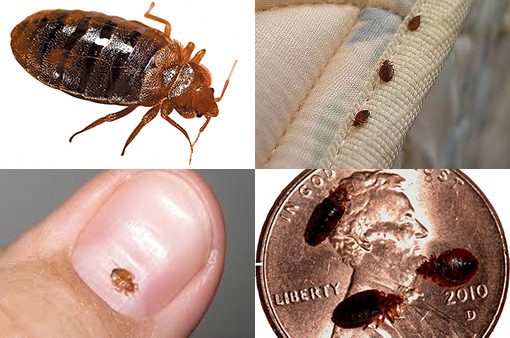Specialist Bed Bug Exterminator: DC Solutions and Heat Treatment
Wiki Article
Exploring the Scientific Research Behind Bed Insect Warmth Treatments as a Lasting Pest Management Approach
One such approach that has actually gained traction in recent years is the use of heat treatments to deal with bed pest infestations. The ins and outs of how warmth effectively eliminates bed bugs and the broader implications for sustainable bug monitoring practices make this a topic worth exploring further.Bed Bug Heat Treatment Process

Thermal Fatality Factor for Bed Insects
Revealing bed bugs to raised temperatures beyond their thermal resistance range is critical for accomplishing reliable removal in warm therapy processes. The thermal fatality factor for bed bugs describes the temperature level at which these insects can not endure. Research suggests that bed pests begin to perish when exposed to temperature levels over 113 ° F(45 ° C) for a sustained period. As the temperature level raises, so does the mortality rate of bed insects. At around 118 ° F(48 ° C ), bed insects start to pass away rapidly, with a mortality price of virtually 99% within minutes of exposure. This demonstrates the level of sensitivity of bed pests to high temperatures and highlights the efficiency of warmth therapies in eradicating invasions. By getting to and keeping temperature levels above the thermal death point for bed insects, bug monitoring professionals can guarantee detailed removal of bed pest populaces, consisting of hard-to-reach locations where chemical therapies might be less effective. Understanding the thermal death point for bed bugs is vital for carrying out effective warmth therapy approaches and attaining lasting parasite monitoring end results.Advantages of Warmth Treatments
Having actually established the critical thermal fatality point for bed pests, it is essential to currently check out the significant benefits that warm therapies use in efficiently eradicating these resistant insects. When compared to traditional chemical approaches, heat therapies present numerous essential advantages. One of the key advantages is that warm can penetrate deep right into splits and gaps where bed insects hide, making certain that even one of the most hard-to-reach locations are heated up to dangerous temperatures. This thorough approach not just eliminates live insects yet likewise targets bed pest eggs, preventing future invasions.In addition, heat treatments are non-toxic and environmentally friendly, making them a lasting parasite management strategy. Unlike chemical pesticides, heat treatments do not leave damaging deposits that can present dangers to human health and wellness or the setting. This facet is specifically vital in delicate settings such as hospitals, schools, and houses where chemical usage might not be preferable.
Furthermore, warm treatments why not check here have a high success rate in eliminating bed bug infestations in a solitary therapy, minimizing the requirement for several check outs and reducing interruption to occupants. This efficiency not just conserves money and time but also gives tranquility of mind to those taking care of bed bug problems.
Performance of Warm Treatment

Research study research studies have continually shown the effectiveness of warm treatments in accomplishing a high rate of bed insect death. Correctly performed investigate this site heat therapies can reach all the gaps and splits where bed bugs might be nurturing, guaranteeing a thorough method to elimination. Furthermore, warm therapies have the added advantage of killing bed insect eggs, which are usually resistant to standard chemical therapies. In general, the efficiency of warmth treatments in removing bed bug invasions makes them a reliable and sustainable parasite management method.
Lasting Parasite Monitoring Conveniences
Applying lasting insect management practices supplies long-lasting benefits for both the environment and public wellness. By using techniques such as heat therapies for insect control, we can reduce the dependence on dangerous chemical pesticides that can have unfavorable effects on ecosystems and human wellness - bed bug heat treatment. Sustainable parasite administration strategies aid in protecting biodiversity by targeting specific bugs without harming non-target microorganisms, thus keeping a balanced ecosystem
Moreover, sustainable bug management methods contribute to the general wellness and wellness of the public. By lessening exposure to hazardous chemicals made use of in standard parasite control methods, warm browse around here therapies offer a more secure alternative for bug monitoring in domestic, industrial, and public rooms. This reduction in chemical usage additionally helps in avoiding chemical deposits from contaminating water, soil, and air, guarding environmental quality.
Final Thought
To conclude, bed bug heat treatments have actually been revealed to be a reliable and sustainable bug monitoring strategy. The thermal death point for bed bugs makes them prone to warm therapies, which have countless benefits over traditional chemical therapies. The performance of heat treatments in eliminating bed bug infestations while reducing environmental effect highlights the capacity of this technique as a lasting option for bug control.The bed insect warm therapy procedure includes increasing the temperature within plagued areas to a level that effectively eliminates bed bugs and their eggs. By getting to and keeping temperature levels over the thermal fatality point for bed bugs, insect management professionals can ensure comprehensive removal of bed pest populaces, consisting of hard-to-reach areas where chemical therapies might be less reliable. One of the main advantages is that heat can penetrate deep right into splits and gaps where bed bugs conceal, making sure that also the most hard-to-reach areas are warmed to dangerous temperatures. Unlike chemical treatments that might leave behind immune populations, warmth therapies provide a environmentally pleasant and safe solution that can pass through deep right into furniture, wall surfaces, and other hard-to-reach areas where bed pests hide.
The thermal fatality point for bed bugs makes them at risk to warm therapies, which have many advantages over typical chemical treatments.
Report this wiki page